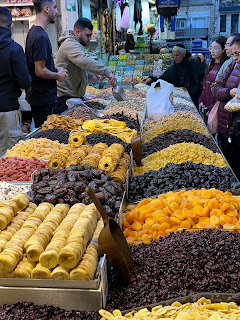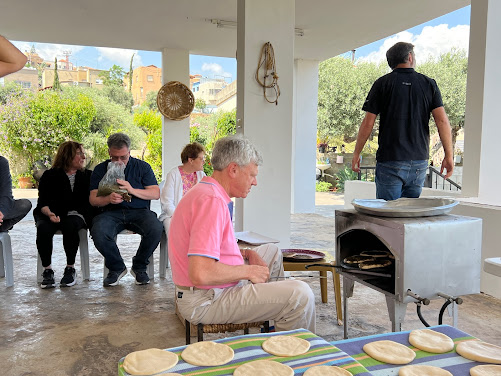Israel Day 7 - May 7, 2023
Sunday was an emotional day of ups and downs. As such, we gained an appreciation for the residents of Jerusalem and the roller-coaster of their lives in this beautiful but highly complex city. We began our day at the quiet and lovely Mishkenot She’ananim in the Jerusalem neighborhood known as Yemin Moshe. Yemin Moshe is located just on the other side of the valley from the Old City. It is built along the hill and was one of the first modern areas of Jerusalem to be established outside the Walls of the Old City. There, until 1967, Jews had built this neighborhood, planted gorgeous trees, shrubs, and flowers, and gazed directly at the Old City which was part of Jordan. For them, it was a way of remembering the past and anticipating the future – a future that became a reality in 1967 as the Israel Defense Forces finally entered the Old City and overtook the Jordanians in one of the most incredible battles in Jerusalem’s long history – ancient and modern. We saw the famous Montefiore’s Windmill, which can be seen throughout Jerusalem, and spoke about the yearning for Zion and the Jewish homeland by Jews in pre-modern and modern history who were suffering from oppression and persecution in Europe in the 18th, 19th, and 20th centuries. To imagine that all of these hundreds of years of yearning became a dream come true in 1967 with the reunification of Jerusalem made more sense to us as we literally stood in the neighborhood of Yemin Moshe and imagined decades of Jews standing in the same place and wondering when and how they would ever be able to call the Old City home again as well.
From Yemin Moshe, now an artist colony and one of the most expensive areas in all of Jerusalem, we went to the nearby Yad Vashem Museum, Israel’s Holocaust Memorial Museum. It is incorrect to view Yad Vashem as a “museum,” per se; rather, it is a living and active remembrance that pays tribute to Holocaust victims and survivors as well as the righteous among the nations who at risk to their own lives aided Jews during World War II. These righteous people among the nations defied Hitler’s explicit order for the Nazis to wipe Jews and Judaism off the face of the planet in extraordinary ways – some saving one person or one family and others, like Oskar Schindler, saving thousands of Jews. No matter how many times I have been at Yad Vashem, I learn new stories and new facts and gain insight into the millions of Jews and non-Jews who ended up in ghettoes, work camps, the forests, and death camps between 1939-1945. A genocide of enormous proportions, Yad Vashem’s indoor and outdoor exhibits, art, documents, displays, and monuments is a magnificent but unfortunate testimony to those who suffered, were tortured, separated from family members, and died during the Holocaust. Yad Vashem exists not only to remember the six million Jews – at least one million of whom died without anyone to identify or remember them – but to help ensure that such an event never happens again to any people at any time for any reason.
Following Yad Vashem, we experienced a typical Israel experience – where dramatically, darkness is immediately followed by light, when joy follows even the deepest tragedy. From the Holocaust Memorial Museum, we went to Israel’s largest Jewish market, Machaneh Yehudah. Just steps from our hotel, we entered the enormous market which spans a square area of several blocks. There, fruits and vegetables, meats and fish, restaurants, cafés spice, olive, and dry goods stores line the market. Bakeries, chocolates, breads, candies, halva, and ice cream parlors provide an unmatched social, cultural, and religious experience that is unique to Jerusalem. As black, white, and gray as Yad Vashem is, Machaneh Yehudah is filled with middle eastern colors, textures, noises, and tastes that afford the visitor to Jerusalem a history and sociological lesson like no other in Israel. We wandered the market, selecting places to try a new food or taste an unfamiliar fruit or vegetable. Some of us ate dinner wandering from one take-out place to another, and some sat down in a restaurant known for its unique cuisine. We all had a great time and returned to the hotel for a short time to pick up a jacket or sweater because after dark we headed back to the Old City for a beautiful light show that explained some of the history of Jerusalem through lights, sounds and videos set against some of the most important archaeological sites in the world.





Comments
Post a Comment